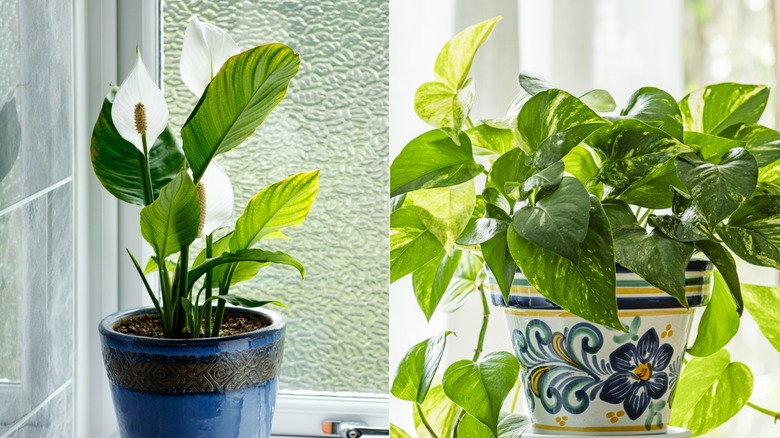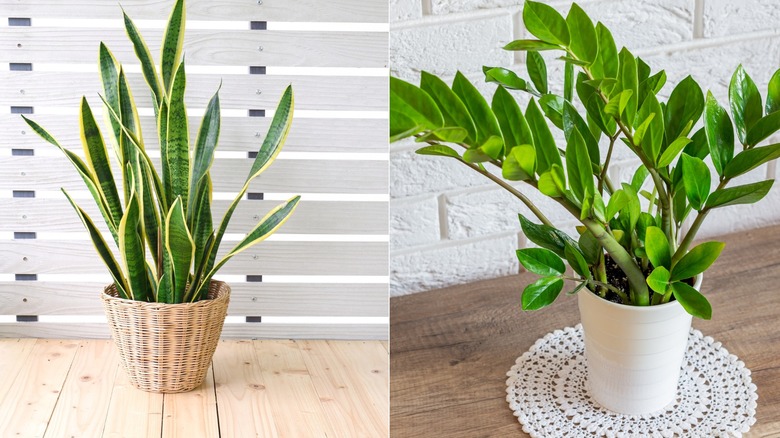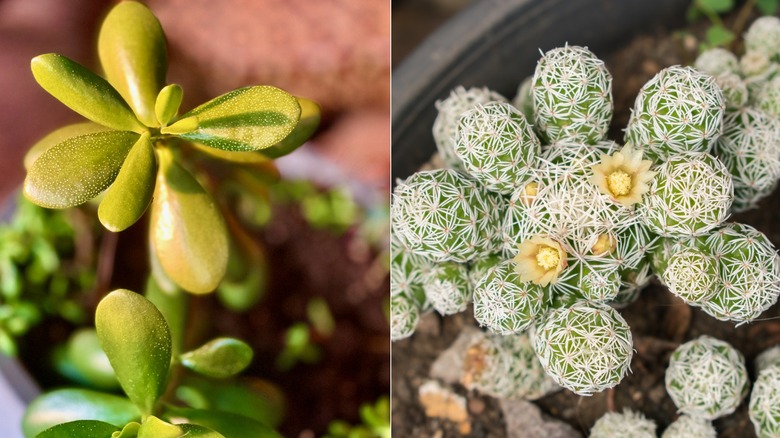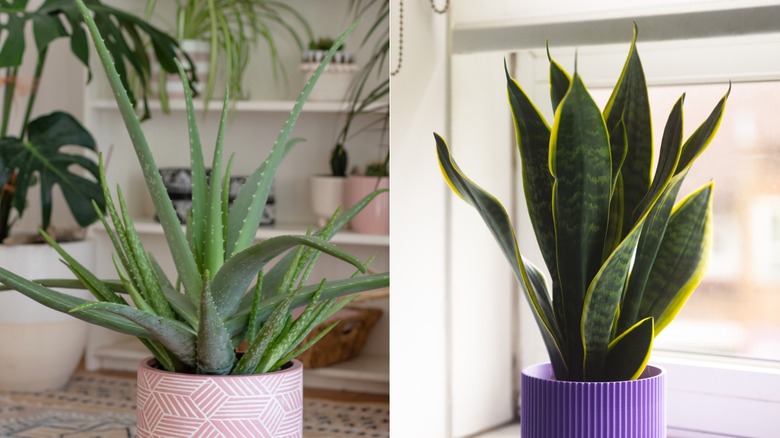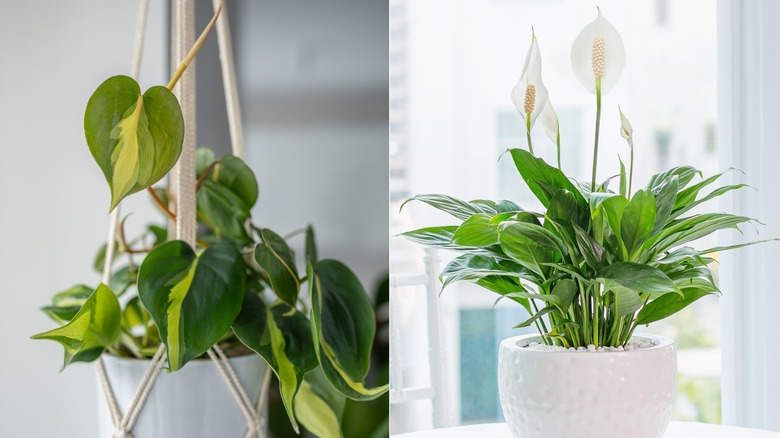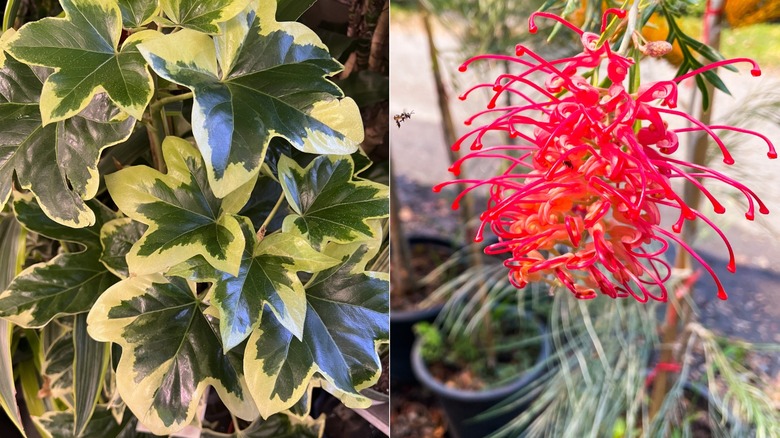Companion Planting Isn't Just For The Garden: Pair These Houseplants Together
You may have heard about how companion planting benefits the plants in your garden, but did you know it can also benefit your houseplants? In the garden, companion planting can impact soil nutrients and pollination, along with several other considerations. But you can actually pair several houseplants together to improve their overall growing conditions, too. However, you will want to make sure that they can handle the same environment and have the same general needs for things like light. You may also want to consider pairing plants that provide benefits to each other. For example, cacti and succulents are commonly paired together because they often have the same general requirements, and they can support each other's growth. However, there are still things to consider when choosing your pairings.
Some of these pairs, like a jade plant and thimble cactus, can be planted together in the same pot, either to combine dramatic height with a low soil cover or side by side to create alternating patterns in a rectangular pot. If you are going to do this, you need to consider plant size, growth rate, water, soil, and light requirements. Other pairs, like aloe and snake plants, can be planted in different pots and placed next to each other or in a larger pot.
Pair your peace lily with pothos for a tranquil environment
Peace lilies (Spathiphyllum spp.) and pothos (Epipremnum aureum) may not seem like the most likely pair, but they complement each other in more ways than one. You can plant them in the same pot so the peace lily grows tall and the pothos vines down the side. Peace lilies like bright, indirect sunlight and damp, but not overly moist, soil. Similarly, pothos can thrive in low light or indirect bright light, which works well with the needs of peace lilies. Plus, they only like water when the soil feels dry.
Plant a snake plant and zz plant together
Snake plants (Sansevieria) are hard-to-kill succulents you can easily learn all about before planting. It is commonly paired with other low-maintenance plants. The ZZ plant (Zamioculcas zamiifolia) is one such plant that is almost as hard to kill as the snake plant. Plus, the two plants have nearly identical light, water, and soil needs, so they can grow together in the same pot. In fact, they grow so well together, they are sometimes sold as a pair. They don't necessarily provide any benefits to each other, but they both tolerate low light and drought conditions.
Your Jade plant will thrive near a thimble cactus
A great succulent and cacti combination that will provide mutual benefits to each other is the jade plant (Crassula argentea) and the thimble cactus (Mammillaria vetula). Both plants are great for beginners because they don't need a lot of attention. You can place them in the same pot or just near each other in a bright window with full sun. You only need to water them once every 3 to 4 weeks. Jade plants will tolerate different types of well-draining soil, but thimble cacti grow best in a cactus potting mix.
Improve your living space by pairing aloe with a snake plant
Succulents, in general, are known to be houseplants that improve indoor air quality, so it's no surprise that pairing two succulents, like aloe (Aloe vera) and snake plants, together can improve your living space. Both plants offer health benefits, which make them even more valuable as companions, plus they have similar growth patterns and sizes that complement each other. They do have slightly different needs, so they may not do well if you try to plant them in the same soil, but overall, they usually do well when growing in the same space.
Accentuate gorgeous foliage by potting your philodendron with a peace lily
If you're not limited on space and want something tall, consider potting a philodendron with a peace lily. Both plants have similar growing requirements, so you won't need to worry about them having issues in the same pot as long as you choose a container that is large enough to accommodate their root systems. There are vining varieties of philodendron that can add pleasant, low-growing foliage accents when combined with tall peace lilies, like 'Sensation', which grows up to 6 feet tall.
Pair a purple passion plant with a polka dot plant to make a statement
If you love a statement plant, you'll adore the combination of a purple passion plant (Gynura spp.) and a polka dot plant (Hypoestes phyllostachya). These stunning ornamental foliage plants can be grown in the same pot, but you will want to make sure they each have enough room to establish roots and spread. The best option is to use a tall rectangular planter. Purple passion plants will tolerate either medium or bright light, but polka dot plants prefer bright light, so it is best to place a combination planter in a spot with plenty of sun.
Fill large spaces with bush ivy and bright grevillea
Sometimes, little plants just aren't enough to satisfy houseplant enthusiasts, so why not try something that will fill large spaces? You can plant bush ivy (Fatshedera lizei) and bright grevillea in the same pot to create an enchanting indoor plant haven that fills your space. Grevillea grows taller than bush ivy and thrives in full sun, but bush ivy does well in partial shade, provided by the growing grevillea. While it is unlikely indoors, Grevillea can grow to be up to 20 feet tall, while bush ivy is generally between 3 and 5 feet tall.
Add a pop of color with a golden shrimp plant and Chinese evergreen
For something a bit more exotic that adds a pop of color to your indoor garden, try combining golden shrimp plant (Pachystachys lutea) and Chinese evergreen (Aglaonema). Both plants love sunny conditions, so you will want to make sure neither one overshadows the other; however, the Chinese evergreen can survive in partial shade if necessary. They also both grow well in slightly acidic, well-draining soil.
Keep it simple with hostas and begonias
For a simple companion plant option that still brings blooms into your house, consider hostas and begonias. Begonias are one of the best companion plants for hostas if you want year-round color indoors or outdoors. Both hostas and begonias like soil that is rich in organic matter, slightly acidic, and well-draining. Plus, they both fare well in full sun or partial shade. Hostas are generally considered easy to care for, but begonias take a bit more attention to keep happy. Overall, though, this pairing brings a simple elegance to your houseplant garden.

